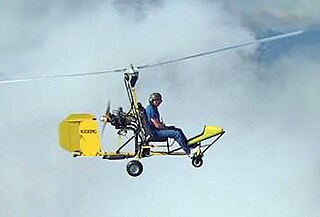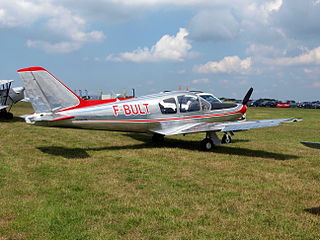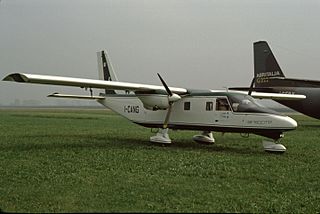Related Research Articles

The Bensen B-8 is a small, single-seat autogyro developed in the United States in the 1950s. Although the original manufacturer stopped production in 1987, plans for homebuilders are still available as of 2019. Its design was a refinement of the Bensen B-7, and like that aircraft, the B-8 was initially built as an unpowered rotor-kite. It first flew in this form in 1955, and on 6 December a powered version, designated B-8M first flew. The design proved to be extremely popular and long-lasting, with thousands of sets of plans sold over the next thirty years.

The Cessna 421 Golden Eagle is an American six or seven seat twin-engined light transport aircraft, developed in the 1960s by Cessna as a pressurized version of the earlier Cessna 411.

The Cessna 414 is an American light, pressurized, twin-engine transport aircraft built by Cessna. It first flew in 1968 and an improved variant was introduced from 1978 as the 414A Chancellor.

The Cessna 340 is a twin piston engine pressurized business aircraft that was manufactured by Cessna.

The Agusta A.101 was a large prototype transport helicopter developed in Italy during the 1960s. Despite prospective orders from the Italian armed forces, no buyers emerged and the project was abandoned in 1971.

The Agusta A.103 was an Italian prototype single-seat light helicopter flown in October 1959. The pilot was enclosed by a perspex bubble with the engine at the rear and the tail rotor carried on an enclosed boom.

The Air Tractor AT-300 is a family of agricultural aircraft that first flew in the United States on September 1973. Type certification was awarded to Air Tractor in November the same year, and serial production commenced in 1976. Of low-wing monoplane taildragger configuration, they carry a chemical hopper between the engine firewall and the cockpit.

The Air Tractor AT-400 is a family of agricultural aircraft that first flew in the United States on September 1979. Type certification was awarded to Air Tractor in April 1980. Of low-wing monoplane taildragger configuration, they carry a chemical hopper between the engine firewall and the cockpit.

The Partenavia P.64B/P.66B Oscar is an Italian two/four-seat, single-engined, high-wing monoplane built by Partenavia.
The Anahuac Tauro is a Mexican agricultural aircraft built in small numbers in the late 1960s and 1970s. The first prototype flew on 3 December 1968, with Mexican Type certification following on 8 August 1969. It was a low-wing braced monoplane of conventional configuration with fixed tailwheel undercarriage. The wing was of constant chord and had spray bars installed along its trailing edge.

The Piper PA-36 Pawnee Brave is a 1970s American single-engined, low-wing, propeller-driven agricultural plane built by Piper Aircraft.

The Cierva CR Twin was a five-seat utility helicopter that first flew in the UK in 1969. It was a joint development between Cierva Autogiro Company and Rotorcraft now a subsidiary of Cierva, based on the dynamic systems of the latter company's Grasshopper design. A new, highly streamlined pod-and-boom fuselage was married to the Grasshopper's coaxial rotor system, and the new aircraft registered G-AWRP first flew on 18 August 1969.

The Emair MA-1 Paymaster was a 1960s American agricultural biplane aircraft built by Emair, which was part of the Hawaiian Murray company. The prototype was constructed and flown in New Zealand, with production aircraft built in the United States at Harlingen, Texas.

The Wing D-1 Derringer is an American light twin-engined two-seat monoplane tourer designed by John Thorp and developed by the Hi-Shear Corporation and built by the Wing Aircraft Company.

The Procaer F.15 Picchio is an Italian-designed light utility aircraft built by Procaer.

The Vulcanair SF.600 Canguro was a feederliner developed in Italy in the late 1970s. Despite a number of attempts to put the aircraft into series production, only a small number were ever built. The Canguro was a high-wing cantilever monoplane of conventional configuration with a fuselage of rectangular cross-section and a high-set tail. The tricycle undercarriage was not retractable, and its main units were carried on sponsons on the fuselage sides. SIAI Marchetti provided funding towards the construction of the prototype, and constructed this aircraft at the former Aviamilano plant. After flight testing proved positive, the type was put on sale, but failed to attract buyers in any number, even when the original piston engines were exchanged for turboprops and retractable undercarriage was offered as an option.

The Maule M-5 is an American four-seat cabin monoplane designed and built by the Maule Aircraft Company.

The IAR-827 was an agricultural aircraft built in Romania in the 1970s and 1980s. The penultimate member of the family of designs that began with the IAR-821, it was, like the others, a conventional low-wing monoplane with fixed, tailwheel undercarriage, and shared the all-metal construction of the IAR-826. The prototype flew in 1976, powered by a Lycoming IO-720 engine, but the production examples that followed all had the PZL-3S.

The Wassmer WA-80 Piranha is a French two-seat low-wing cabin monoplane trainer designed and built by Société Wassmer. Based on the same construction as the company's WA-50 four-seater, the WA-80 was a scaled down version. The prototype, registered F-WVKR, first flew in November 1975 powered by a 100 hp Rolls-Royce Continental O-200 engine. Wassmer appointed a receiver and suspended production in 1977 after 25 had been built.

The Valentin Taifun is a two-seat self-launching sailplane designed and built by Valentin Flugzeugbau GmbH of Hasfurt, Germany.
References
- ↑ Air Progress: 19. December 1971.
{{cite journal}}: CS1 maint: untitled periodical (link) - ↑ Taylor 1983 , p. 185
- ↑ Simpson 1998 , p. 207
- ↑ Taylor 1982, pp. 177–178
- Taylor, John W. R. (1982). Jane's All the World's Aircraft 1982–83. London: Jane's Yearbooks. ISBN 0-7106-0748-2.
- Taylor, John W. R. (1983). Jane's All the World's Aircraft 1983–84. London: Jane's Yearbooks. ISBN 0-7106-0780-6.
- Taylor, Michael J. H. (1989). Jane's Encyclopedia of Aviation. London: Studio Editions. p. 51.
- Simpson, R. W. (1998). Airlife's Helicopters and Rotorcraft. Ramsbury: Airlife Publishing. ISBN 1-85310-968-1.